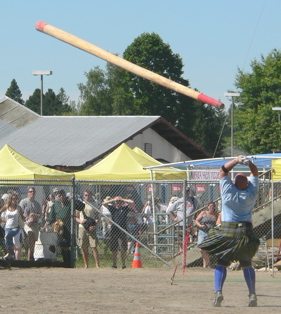|
TOSSING THE CABER
|
|||||
|
HOME | BIOLOGY | FILMS | GEOGRAPHY | HISTORY | INDEX | INVESTORS | MUSIC | SOLAR BOATS | SPORT |
|||||
|
The caber toss is a traditional Scottish athletic event involving the tossing of a large wooden pole called a caber, similar to a telephone pole.
Tossing the Caber
Rules and technique
There are no uniform standards for cabers specifying length, weight, type of wood, density, circumference, etc. In general, the cabers used in competitions vary in all these characteristics with each Highland Games event having their own set of cabers. Typically, a Highland Games event will have several cabers varying in length and weight, with the longer, heavier implements being used for the Professional or top class event and the shorter, lighter cabers being used for either qualifying for the top class or for the Amateur class. Others, shorter and lighter yet, might used for the women's and junior classes if the Games event features such competitions. The first photograph in the gallery below shows a group of cabers from the 2005 Bellingham Highland Games.
A traditional caber is around 16–20 feet (5–6 m) long and weighs around 80–130 pounds (35–60 kg). The size, and particularly the length, of the caber means that enormous strength is required simply to balance it vertically, and even more is required to toss it. For competitions involving less skilled athletes a shorter and/or lighter caber is used. It is not unusual for a caber to break in the course of a competition.
To toss the caber, the thrower first cups their hands together. The caber is then held vertically with the 'bottom' end in the thrower's cupped hands. Continuing to hold the caber vertically (which requires a good deal of careful balance), the thrower runs forward and tosses the caber into the air so that it turns 180° end-over-end in the air and lands on the former 'top' end. Because the caber still has angular momentum, the former 'bottom' end then (hopefully) falls forward and away from the thrower.
The object is not the distance of the throw, but rather to have the caber fall directly away from the thrower after landing. A perfect throw ends with the 'top' end nearest to the thrower and the 'bottom' end pointing exactly away. If the throw is not perfect, it is scored by viewing the caber as though it were a hand on the clock. The ideal position is 12:00. A caber pointing to 11:00 would yield a better score than one pointing to 10:30. If the caber lands on its end and falls back towards the thrower, the score is lower than for any throw that falls away from the thrower but will be based upon the maximum vertical angle that the caber achieved. An angle of 87° is better than 75°.
Highland games traditional sporting event
LINKS and REFERENCE
http://www.crieff-highland-games.co.uk/caber.html http://www.lochness.co.uk/hgames/caber.html
A - Z SPORTS INDEX
A taste for adventure capitalists
Solar Cola - a healthier alternative
|
|||||
|
This
website
is Copyright © 1999 & 2006 NJK. The bird |
|||||
|
AUTOMOTIVE | BLUEBIRD | ELECTRIC CARS | ELECTRIC CYCLES | SOLAR CARS |

